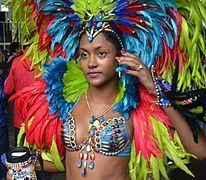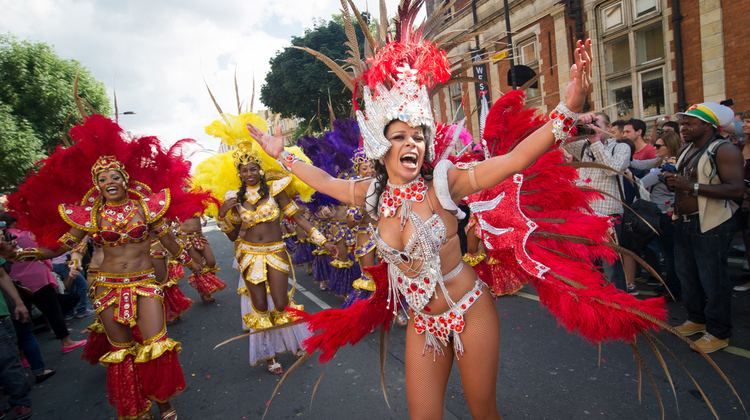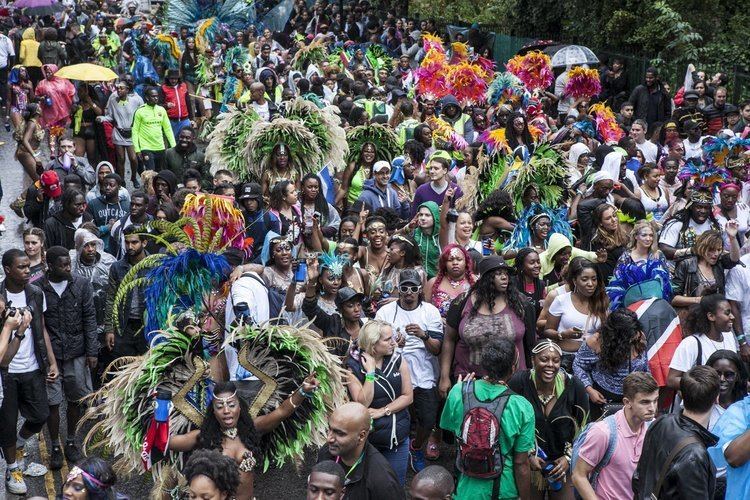Years active 1966–present | ||
 | ||
Genres Reggae, Soca music, Pop music Similar | ||
Notting hill carnival 2016 link up tv
The Notting Hill Carnival is an annual event that has taken place since 1966 on the streets of Notting Hill, and the Royal Borough of Kensington and Chelsea, London, England, each August over two days (the August bank holiday Monday and the preceding Sunday). It is led by members of the British West Indian community, and attracts around one million people annually, making it one of the world's largest street festivals, and a significant event in British culture. In 2006, the UK public voted it onto the list of icons of England. Despite its name, it is not part of the global Carnival season preceding Lent.
Contents
- Notting hill carnival 2016 link up tv
- Notting hill carnival 2016 monday madness
- History
- Public order
- References

Notting hill carnival 2016 monday madness
History

Professor David Dabydeen has stated: "Carnival is not alien to British culture. Bartholomew Fair and Southwark Fair in the 18th century were moments of great festivity and release. There was juggling, pickpocketing, whoring, drinking, masquerade — people dressed up as the Archbishop of Canterbury and indulged in vulgar acts. It allowed people a space to free-up but it was banned for moral reasons and for the antiauthoritarian behaviour that went on like stoning of constables. Carnival allowed people to dramatise their grievances against the authorities on the street... Notting Hill Carnival single-handedly revived this tradition and is a great contribution to British cultural life." Bartholomew's Fair was suppressed in 1855 by the City authorities for encouraging debauchery and public disorder.

The roots of the Notting Hill Carnival that took shape in the mid-1960s come from two separate but connected strands. A "Caribbean Carnival" was held on 30 January 1959 in St Pancras Town Hall as a response to the problematic state of race relations at the time; the UK's first widespread racial attacks, the Notting Hill race riots in which 108 people were charged, had occurred the previous year. The 1959 event, held indoors and televised by the BBC, was organised by the Trinidadian Claudia Jones (often described as "the mother of the Notting Hill Carnival") in her capacity as editor of Britain's first black newspaper The West Indian Gazette, and directed by Edric Connor; showcasing elements of a Caribbean carnival in a cabaret style, it "featured among other things the Mighty Terror singing the calypso 'Carnival at St Pancras', a Caribbean Carnival Queen beauty contest, the Trinidad All Stars and Hi–fi steel bands dance troupe and a Grand Finale Jump-Up by West Indians who attended the event."

The other important strand was the "hippie" London Free School-inspired festival in Notting Hill that became the first organised outside event in August 1966. The prime mover was Rhaune Laslett, who was not aware of the indoor events when she first raised the idea. This festival was a more diverse Notting Hill event to promote cultural unity. A street party for neighbourhood children turned into a carnival procession when Russell Henderson's steel band (who had played at the earlier Claudia Jones events) went on a walkabout. By 1970, "the Notting Hill Carnival consisted of 2 music bands, the Russell Henderson Combo and Selwyn Baptiste’s Notting Hill Adventure Playground Steelband and 500 dancing spectators."

Among the early bands to participate were Ebony Steelband and Metronomes Steelband. "Notting Hill Carnival became a major festival in 1975 when it was organised by a young teacher, Leslie Palmer." Palmer, who was director from 1973 to 1975, is credited with "getting sponsorship, recruiting more steel bands, reggae groups and sound systems, introducing generators and extending the route." He encouraged traditional masquerade, and for the first time in 1973 costume bands and steel bands from the various islands took part in the street parade, alongside the introduction of stationary sound systems, as distinct from those on moving floats, which as Alex Pascall has explained: "created the bridge between the two cultures of carnival, reggae and calypso." The carnival was also popularised by live radio broadcasts by Pascall on his daily Black Londoners programme for BBC Radio London.

Notting Hill Carnival is very reminiscent of Jamaican dancehall sessions due to the sounding of the event creating a "space". Notting Hill Carnival’s use of sound systems invokes cultural and personal associations for listeners, bringing about another "space", or a home for populations of the Black Atlantic Diaspora. Physically, the dominance of the sound envelops the crowd, creating a setting for the Carnival even though there are no physical boundaries. The fact that the sound systems are in the streets precipitates an environment where participants hear the sounds before they can actually see the systems themselves. The experience that all of these factors brings about for participants of the Carnival is representative of the Carnival-goers becoming a part of the larger diaspora, and acquiring a feeling of a distant African homeland, without having seen or having first-hand knowledge of the African continent.
Emslie Horniman's Pleasance (in the nearby Kensal Green area), with Kensal Green and Westbourne Park tube stations its closest tube station, has been the carnival's traditional starting point.
As the carnival had no permanent staff and head office, the Mangrove restaurant in Notting Hill, run by another Trinidadian, Frank Crichlow, came to function as an informal communication hub and office address for the carnival's organisers. By 1976, the event had become definitely Caribbean in flavour, with around 150,000 people attending. However, in that year and several subsequent years, the carnival was marred by riots, in which predominantly Caribbean youths fought with police — a target due to the continuous harassment the population felt they were under. During this period, there was considerable press coverage of the disorder, which some felt took an unfairly negative and one-sided view of the carnival. For a while it looked as if the event would be banned. Prince Charles was one of the few establishment figures who supported the event.
Concerns about the size of the event resulted in London's then mayor, Ken Livingstone, setting up a Carnival Review Group to look into "formulating guidelines to safeguard the future of the Carnival". An interim report by the review resulted in a change to the route in 2002. When the full report was published in 2004, it recommended that Hyde Park be used as a "savannah"; though this move has attracted some concern that the Hyde Park event might overshadow the original street carnival.
In 2003, the Notting Hill Carnival was run by a limited company, the Notting Hill Carnival Trust Ltd. A report by the London Development Agency on the 2002 Carnival estimated that the event contributes around £93 million to the London and UK economy. However the 2016 residents survey found that many businesses had to close & only 6% reported an upturn in trade.
In 2005, entrants from the Notting Hill Carnival participated in the Bridgwater, Somerset, carnival — Europe's largest lighted carnival and part of the West Country Carnival circuit.
For the 2011 Notting Hill Carnival an iPhone app was released, and in 2012 both iPhone and Android apps.
For 2014, a Notting Hill Carnival illustrated guide was created by official city guide to London visitlondon.com. The infographic includes Carnival tips, transport information and a route map. The book Carnival: A Photographic and Testimonial History of the Notting Hill Carnival, by Ishmahil Blagrove and Margaret Busby, was also published in August 2014 by Rice N Peas.
In 2015 there was controversy when the Nottinghill Carnival Trust charged journalists £100, to cover the event and demanded copies of all work produced relating to the event within three weeks of the end of the Carnival. The National Union of Journalists organised a boycott of the event. In 2016 the charge remains.
In 2016, 42 hours of live video coverage of Notting Hill Carnival was broadcast by music live streaming platform Boiler Room from the Rampage, Deviation, Aba Shanti-I, Channel One, Nasty Love, Saxon Sound, King Tubbys, Gladdy Wax and Disya Jeneration soundsystems.
Public order
Since the carnival did not have local authority permission, initial police involvement was aimed at preventing it taking place at all, which resulted in regular confrontation and riots. One notable time when this occurred was in 1976; police had been expecting hostility due to what they deemed as trouble the year before. Consequently, after discovering pickpockets in the crowd, police took a heavy-handed approach against the large congregation of blacks and it became "no-man's land". The 1600 strong police force violently broke up the carnival, resulting in the arrest of 60 people. In the aftermath of the event, the carnival was portrayed in a very pointed way, with those aiding the riots lumped together as the "trouble-makers" responsible.
A change of policy came after a confrontation in 1987, which saw a change to allowing the Carnival to take place with police taking a more conciliatory approach. During the 2000 Carnival, two men were murdered and future policing, while conciliatory, has led to police deployment in large numbers — upwards of 11,000. Some of the crime associated has been displaced to the periphery. In 2007, two teenagers were shot just outside the carnival area. The review in 2000 by participants (but not local residents) resisted calls from the Mayor of London to relocate the event to Hyde Park, but led to the parades taking a circular rather than linear route.
The 2008 Carnival was marred by rioting right at the very end of the weekend, involving large numbers of youths and injuries to police. Some media outlets captured footage of the violence; approximately 500 youths were arrested. The carnival has come under criticism for its cost to the London taxpayer as the cost for policing the event totalled more than £6,000,000; however, it is argued that this should be put into context since the carnival is estimated to bring in approximately £93,000,000 into the local economy.
Despite talk of the 2011 Carnival being cancelled in the wake of the early August riots in the UK that year, it was seen as being relatively peaceful. Five people were arrested for a stabbing at Ladbroke Grove. The victim was one of 86 people who were taken to hospital. In total 245 people were detained by police over the two days of the carnival.
In recent years, the event has been much freer from serious trouble; apart from the stabbings & increasing numbers of arrests and is generally viewed very positively by the Authorities as a dynamic celebration of London's multicultural diversity, though dominated by the Caribbean culture. However, there has been controversy over the public safety aspects of holding such a well attended event in narrow streets in a small area of London. A survey in 2016 however found that nine out of ten residents living along the route of the Notting Hill Carnival flee their homes to escape the “frightening and intimidating” event.
In 2016 there were over 450 arrests and five people were hurt in four knife attacks.
Since 1987 there have been five deaths caused by violence at Notting Hill Carnival:
